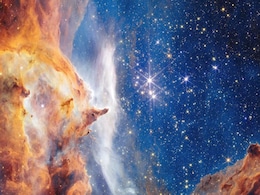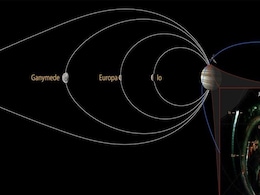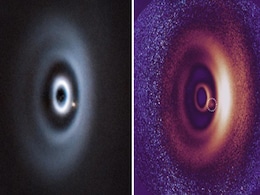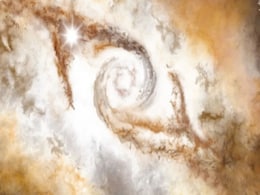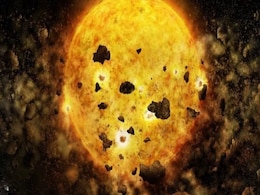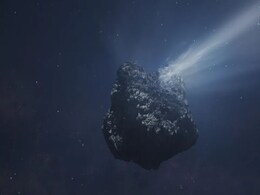Gas Giants
- All
- News
- Videos
-

James Webb Space Telescope Spots an Exoplanet Losing Its Atmosphere in a Huge Helium Stream
- Thursday December 4, 2025
Astronomers using NASA’s James Webb Space Telescope have observed a massive helium cloud escaping from the super-puff exoplanet WASP-107b, marking the first direct detection of such atmospheric loss. Webb’s infrared data reveal an enormous exosphere nearly ten times the planet’s radius, with helium streaming both ahead of and behind the plane...
-
 www.gadgets360.com
www.gadgets360.com
-

New Images of Interstellar Object 3I/ATLAS Show a Giant Jet Shooting Toward the Sun
- Sunday October 26, 2025
New telescope images show interstellar comet 3I/ATLAS ejecting a giant jet of gas and dust toward the Sun. Scientists say the phenomenon confirms its natural cometary behaviour, offering clues about how such ancient interstellar visitors react to solar heat.
-
 www.gadgets360.com
www.gadgets360.com
-

Astronomers Capture First-Ever Image Of A Baby Planet Forming In Real Time
- Tuesday October 7, 2025
- Science |
Astronomers have made a groundbreaking discovery by directly observing a young protoplanet, WISPIT 2b, embedded in a ring-shaped gap in a disk around a young star.
-
 www.ndtv.com
www.ndtv.com
-

Universe’s First Stars May Have Been Smaller Than Astronomers Once Believed
- Tuesday September 9, 2025
Astronomers once thought the universe’s first stars were only massive giants. New simulations and lab experiments reveal turbulence and early chemistry allowed smaller, Sun-like stars to form too. This discovery reshapes our view of cosmic dawn, showing the first stellar generation was more diverse than previously believed.
-
 www.gadgets360.com
www.gadgets360.com
-

NASA's James Webb Space Telescope Captures Lobster Nebula’s Towering Spires and Massive Stars
- Monday September 8, 2025
NASA’s Webb Telescope imaged the Lobster Nebula (NGC 6357), 5,500 light-years away. Its young star cluster, Pismis 24, contains giant stars carving glowing gas pillars. Pismis 24-1, once thought to be one supermassive star, is a triple system with stars up to 74 times the Sun’s mass.
-
 www.gadgets360.com
www.gadgets360.com
-

NASA’s Juno Spacecraft Detects Callisto’s Aurora, Completing Jupiter’s Galilean Moons Set
- Wednesday September 3, 2025
NASA’s Juno spacecraft has captured Callisto’s elusive auroral footprint, completing the “family portrait” of Jupiter’s Galilean moons. Each moon carves its own aurora into the gas giant’s poles, revealing how they interact with Jupiter’s powerful magnetosphere. Callisto’s faint arc appeared during a 2019 flyby, finally confirming i...
-
 www.gadgets360.com
www.gadgets360.com
-

A Planet Is Being Born: Astronomers Capture Rare Cosmic Snapshot
- Saturday August 30, 2025
Astronomers have captured a groundbreaking sight: WISPIT 2b, a baby gas giant planet forming within a dusty, multi-ring protoplanetary disk around a young Sun-like star 430 light-years away. Infrared images from the Very Large Telescope show the planet carving a dark path in the rings as it feeds on gas and dust. This rare discovery provides the fi...
-
 www.gadgets360.com
www.gadgets360.com
-

James Webb Telescope Detects Potential Gas Giant Exoplanet Just 4 Light-Years Away
- Friday August 8, 2025
Astronomers using JWST have spotted a possible gas giant orbiting Alpha Centauri A, only 4 light-years away. If confirmed, it would be the closest exoplanet to a Sun-like star ever imaged. The discovery could challenge current models of planetary formation in binary systems and open new opportunities for studying nearby worlds.
-
 www.gadgets360.com
www.gadgets360.com
-

Massive 200-Light-Year Cloud May Be Channeling Matter to the Milky Way's Core
- Saturday August 2, 2025
Astronomers have discovered a massive, 200-light-year-wide cloud of gas and dust—dubbed the Midpoint cloud—hidden in the Milky Way. This giant molecular cloud appears to channel dense material into the galaxy’s core, possibly fueling star formation. The discovery offers rare insights into how matter flows from the galaxy’s disk to its turbu...
-
 www.gadgets360.com
www.gadgets360.com
-

Doomed Exoplanet TOI-2109b Spirals Toward Its Star with Three Possible Fates
- Monday July 28, 2025
The gas giant TOI-2109b, over five times Jupiter’s mass, is spiraling closer to its star in a rare planetary death spiral. With a 16-hour orbit and blistering heat, the exoplanet could either plunge into its host star, be torn apart by tidal forces, or evolve into a rocky super-Earth through photoevaporation. NASA’s TESS and ESA’s Cheops data...
-
 www.gadgets360.com
www.gadgets360.com
-

Trump's AI Plan Calls For Massive Data Centers, May Affect Energy In US
- Friday July 25, 2025
- World News | Associated Press
President Donald Trump's plan to boost artificial intelligence and build data centers across the US could speed up a building boom that was already expected to strain the nation's ability to power it.
-
 www.ndtv.com
www.ndtv.com
-

Young Exoplanet Spotted Shedding Atmosphere Under Stellar Radiation
- Thursday July 17, 2025
NASA’s Chandra X-ray Observatory and Hubble Space Telescope have captured a dramatic cosmic event: a baby exoplanet, TOI 1227 b, is being stripped of its atmosphere by powerful X-rays from its host star. Only 8 million years old and orbiting a red dwarf, this Jupiter-sized planet is losing gas at a rate equal to Earth’s entire atmosphere every ...
-
 www.gadgets360.com
www.gadgets360.com
-

Did Something Hit Saturn? Astronomers Investigate Possible Impact Flash
- Wednesday July 9, 2025
- Science |
Unlike rocky planets where asteroid impacts leave visible craters, gas giants like Saturn have outer layers of hydrogen and helium that can absorb impacts without obvious traces.
-
 www.ndtv.com
www.ndtv.com
-

Scientists Spotted the Largest Comet Lying in the Solar System’s Outskirts with Outbursting Gases
- Saturday June 21, 2025
NASA confirms comet C/2014 UN271, the largest known from the Oort Cloud, is chemically active. Detected by ALMA from far beyond Neptune, the comet’s carbon monoxide jets offer rare insights into icy body chemistry and early solar system conditions.
-
 www.gadgets360.com
www.gadgets360.com
-

James Webb Space Telescope Spots an Exoplanet Losing Its Atmosphere in a Huge Helium Stream
- Thursday December 4, 2025
Astronomers using NASA’s James Webb Space Telescope have observed a massive helium cloud escaping from the super-puff exoplanet WASP-107b, marking the first direct detection of such atmospheric loss. Webb’s infrared data reveal an enormous exosphere nearly ten times the planet’s radius, with helium streaming both ahead of and behind the plane...
-
 www.gadgets360.com
www.gadgets360.com
-

New Images of Interstellar Object 3I/ATLAS Show a Giant Jet Shooting Toward the Sun
- Sunday October 26, 2025
New telescope images show interstellar comet 3I/ATLAS ejecting a giant jet of gas and dust toward the Sun. Scientists say the phenomenon confirms its natural cometary behaviour, offering clues about how such ancient interstellar visitors react to solar heat.
-
 www.gadgets360.com
www.gadgets360.com
-

Astronomers Capture First-Ever Image Of A Baby Planet Forming In Real Time
- Tuesday October 7, 2025
- Science |
Astronomers have made a groundbreaking discovery by directly observing a young protoplanet, WISPIT 2b, embedded in a ring-shaped gap in a disk around a young star.
-
 www.ndtv.com
www.ndtv.com
-

Universe’s First Stars May Have Been Smaller Than Astronomers Once Believed
- Tuesday September 9, 2025
Astronomers once thought the universe’s first stars were only massive giants. New simulations and lab experiments reveal turbulence and early chemistry allowed smaller, Sun-like stars to form too. This discovery reshapes our view of cosmic dawn, showing the first stellar generation was more diverse than previously believed.
-
 www.gadgets360.com
www.gadgets360.com
-

NASA's James Webb Space Telescope Captures Lobster Nebula’s Towering Spires and Massive Stars
- Monday September 8, 2025
NASA’s Webb Telescope imaged the Lobster Nebula (NGC 6357), 5,500 light-years away. Its young star cluster, Pismis 24, contains giant stars carving glowing gas pillars. Pismis 24-1, once thought to be one supermassive star, is a triple system with stars up to 74 times the Sun’s mass.
-
 www.gadgets360.com
www.gadgets360.com
-

NASA’s Juno Spacecraft Detects Callisto’s Aurora, Completing Jupiter’s Galilean Moons Set
- Wednesday September 3, 2025
NASA’s Juno spacecraft has captured Callisto’s elusive auroral footprint, completing the “family portrait” of Jupiter’s Galilean moons. Each moon carves its own aurora into the gas giant’s poles, revealing how they interact with Jupiter’s powerful magnetosphere. Callisto’s faint arc appeared during a 2019 flyby, finally confirming i...
-
 www.gadgets360.com
www.gadgets360.com
-

A Planet Is Being Born: Astronomers Capture Rare Cosmic Snapshot
- Saturday August 30, 2025
Astronomers have captured a groundbreaking sight: WISPIT 2b, a baby gas giant planet forming within a dusty, multi-ring protoplanetary disk around a young Sun-like star 430 light-years away. Infrared images from the Very Large Telescope show the planet carving a dark path in the rings as it feeds on gas and dust. This rare discovery provides the fi...
-
 www.gadgets360.com
www.gadgets360.com
-

James Webb Telescope Detects Potential Gas Giant Exoplanet Just 4 Light-Years Away
- Friday August 8, 2025
Astronomers using JWST have spotted a possible gas giant orbiting Alpha Centauri A, only 4 light-years away. If confirmed, it would be the closest exoplanet to a Sun-like star ever imaged. The discovery could challenge current models of planetary formation in binary systems and open new opportunities for studying nearby worlds.
-
 www.gadgets360.com
www.gadgets360.com
-

Massive 200-Light-Year Cloud May Be Channeling Matter to the Milky Way's Core
- Saturday August 2, 2025
Astronomers have discovered a massive, 200-light-year-wide cloud of gas and dust—dubbed the Midpoint cloud—hidden in the Milky Way. This giant molecular cloud appears to channel dense material into the galaxy’s core, possibly fueling star formation. The discovery offers rare insights into how matter flows from the galaxy’s disk to its turbu...
-
 www.gadgets360.com
www.gadgets360.com
-

Doomed Exoplanet TOI-2109b Spirals Toward Its Star with Three Possible Fates
- Monday July 28, 2025
The gas giant TOI-2109b, over five times Jupiter’s mass, is spiraling closer to its star in a rare planetary death spiral. With a 16-hour orbit and blistering heat, the exoplanet could either plunge into its host star, be torn apart by tidal forces, or evolve into a rocky super-Earth through photoevaporation. NASA’s TESS and ESA’s Cheops data...
-
 www.gadgets360.com
www.gadgets360.com
-

Trump's AI Plan Calls For Massive Data Centers, May Affect Energy In US
- Friday July 25, 2025
- World News | Associated Press
President Donald Trump's plan to boost artificial intelligence and build data centers across the US could speed up a building boom that was already expected to strain the nation's ability to power it.
-
 www.ndtv.com
www.ndtv.com
-

Young Exoplanet Spotted Shedding Atmosphere Under Stellar Radiation
- Thursday July 17, 2025
NASA’s Chandra X-ray Observatory and Hubble Space Telescope have captured a dramatic cosmic event: a baby exoplanet, TOI 1227 b, is being stripped of its atmosphere by powerful X-rays from its host star. Only 8 million years old and orbiting a red dwarf, this Jupiter-sized planet is losing gas at a rate equal to Earth’s entire atmosphere every ...
-
 www.gadgets360.com
www.gadgets360.com
-

Did Something Hit Saturn? Astronomers Investigate Possible Impact Flash
- Wednesday July 9, 2025
- Science |
Unlike rocky planets where asteroid impacts leave visible craters, gas giants like Saturn have outer layers of hydrogen and helium that can absorb impacts without obvious traces.
-
 www.ndtv.com
www.ndtv.com
-

Scientists Spotted the Largest Comet Lying in the Solar System’s Outskirts with Outbursting Gases
- Saturday June 21, 2025
NASA confirms comet C/2014 UN271, the largest known from the Oort Cloud, is chemically active. Detected by ALMA from far beyond Neptune, the comet’s carbon monoxide jets offer rare insights into icy body chemistry and early solar system conditions.
-
 www.gadgets360.com
www.gadgets360.com






